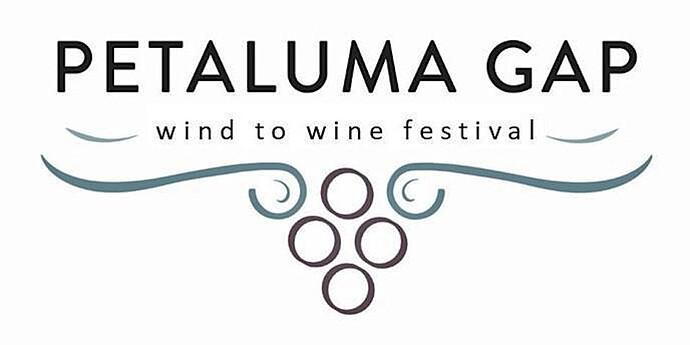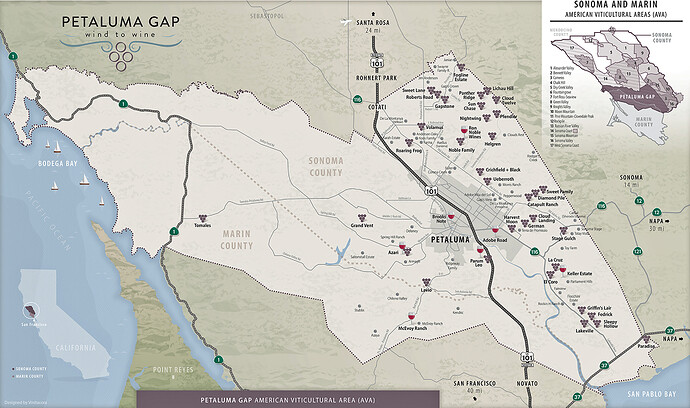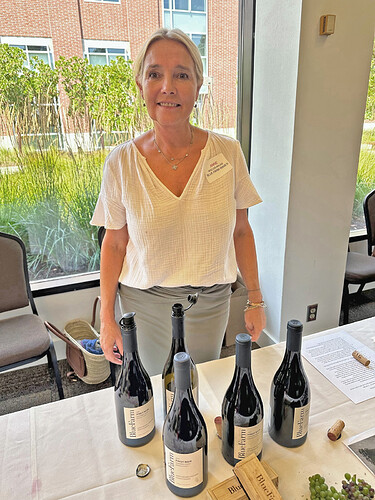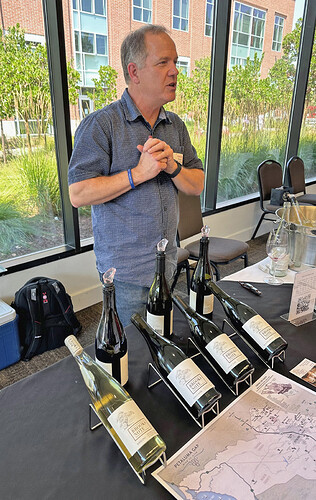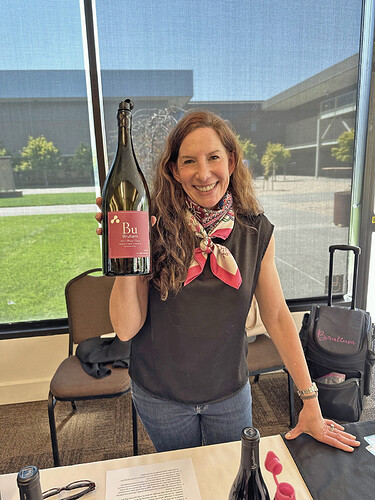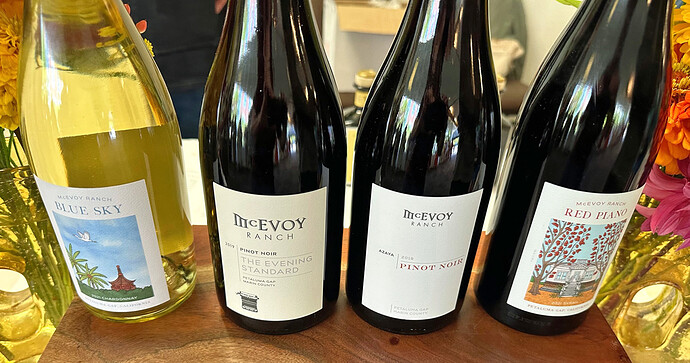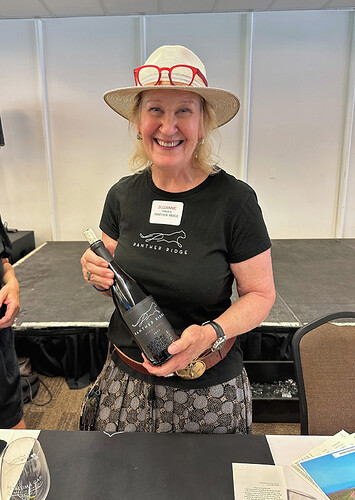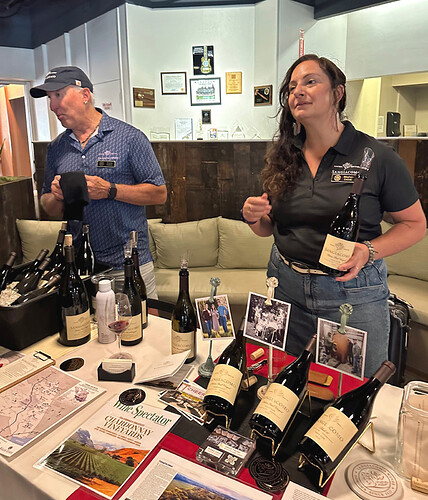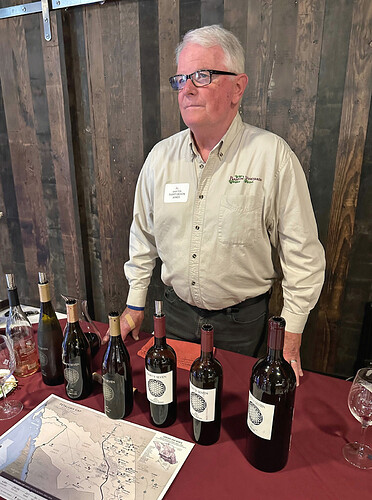Petaluma Gap Wind to Wine Festival – August 5th, 2023
I attended the recent Petaluma Gap Wind to Wine Festival in Rohnert Park, and wrote a report for the Grape-Nutz.com website. An abbreviated version of the report is below – there are lots more photos plus tasting impressions from 17 wineries here: Petaluma Gap Wind to Wine Festival – August 5th, 2023
Report on the Petaluma Gap Wind to Wine Festival, held on Saturday August 5th, 2023 at SOMO Village in Rohnert Park, California. The focus of the event is on wines from the Petaluma Gap winegrape-growing region.
The Wind to Wine Festival is hosted by the Petaluma Gap Winegrowers Alliance (PGWA). Founded in 2005, this is an organization of wineries, growers, and other associate members. The PGWA seeks to promote the growers and vintners who work with winegrapes from the Petaluma Gap AVA, and to increase public awareness of the area’s history and current practices in grapegrowing and winemaking. Tom Gandell of Cline Cellars is the current President of the PGWA and Cheryl Quist is the organization’s Executive Director.
Long recognized as a distinct winegrape growing area within the broader Sonoma Coast region, the Petaluma Gap AVA was officially approved by the Federal Government in late 2017. Located in the southern part of Sonoma County and extending into the northern part of Marin County, the Petaluma Gap AVA’s name refers to the 15-mile wide gap in the coastal mountains that draws cool air from the Pacific Ocean and funnels it toward San Pablo Bay. The resulting wind that this creates is considered one of the Petaluma Gap’s defining climatic characteristics, as is the morning and late-afternoon fog that often blankets much of the area, helping to make it one of the coolest winegrape-growing regions in California. Growers and vintners in the area speak of the wind’s effect on the grapes themselves – smaller berries with thicker skins than are found in many other areas.
The area’s first commercial winery was established in 1884. There were grapevines planted there earlier, though no pre-1900 vines still exist in the region. The Petaluma Gap is currently home to over 70 vineyards with over 4,000 acres of vines. Pinot Noir is by far the most widely-planted grape variety, followed by Chardonnay and Syrah, along with small plantings of other varieties including Albariño, Riesling, Viognier, Grenache, Merlot, Cabernet Franc, and Cabernet Sauvignon.
Map courtesy of the Petaluma Gap Winegrowers Alliance
General Tasting Impressions
The first few Petaluma Gap Wind to Wine Festival events were held in the mid-2010s, and after a hiatus of several years, the event was re-launched in 2022. A date conflict prevented me from attending last year’s tasting, so I was glad to be able to make it this year. The PGWA currently includes over 35 member wineries, and nearly 30 of them poured at this year’s tasting. As is the case with many other region-based organizations such as PGWA, not all of the wineries themselves are located within the Petaluma Gap but still source fruit from there.
I tasted at 17 of the winery tables at this event, though I missed a few that I’d hoped to check out due to time constraints. As you would expect from the Petaluma Gap region, the tasting was heavy on Pinot Noir, though Chardonnay and Syrah were notable as well, and there were also some other interesting varieties poured. The number of wines made by different vintners from the same vineyard sources (Gap’s Crown, Sangiacomo Roberts Road, etc.) meant that there was a similarity to many of them – perhaps a good sign of typicity of these sites. Other producers highlighted their own estate vineyards, and in many cases these stood out as being distinct. In general, the Petaluma Gap wines – particularly the Pinot Noirs – struck me as being somewhat bigger and more structured than you find from many other California growing regions, and there was a savory quality to a number of them that I enjoyed.
I didn’t include older library wines or pre-release and barrel sample wines in the list of favorites below, though several of those were very good. Also, the selected tasting impressions below don’t cover every wine I tasted at the event, but include the wines I felt were most noteworthy, with at least one from each winery table I stopped at. While the list is understandably dominated by Pinot Noir, I should note that the Syrahs on the list were particularly outstanding, some of the best wines of the day.
In many tastings, I can’t single out one overall favorite producer, but in this case I felt that every wine I tasted from McEvoy Ranch was a standout. Other particularly strong wine lineups included those from Blue Farm, Brooks Note, Bruliam, DeLoach, Gust, Panther Ridge, Sangiacomo Family, and Thirty-Seven, while a number of others were also very good. Several producers that were new to me or that I hadn’t checked out in a number of years poured very good wines, including Blue Farm, Bruliam, Gust, Panther Ridge, Parum Leo, Sangiacomo Family, and Thirty-Seven.
The Wind to Wine Festival was a very enjoyable event with plenty of standout wines, and it did a good job of showcasing the Petaluma Gap region. This tasting helped confirm that the wines from the Petaluma Gap are indeed distinctive, and that the foggy, windswept vineyards of the region are among the best cooler-climate sites in California. For those looking to learn more about the wines of the Petaluma Gap, mark your calendars for next year’s Wind to Wine Festival.
Favorites
Whites and Rosés
McEvoy Ranch 2021 “Blue Sky” Chardonnay
Panther Ridge 2022 Rosé of Pinot Noir
Parum Leo 2021 Petaluma Gap Chardonnay
Sangiacomo Family 2020 Roberts Road Vineyard Chardonnay
Reds
Blue Farm 2021 Gap’s Crown Vineyard Pinot Noir
Brooks Note 2021 Petaluma Gap Pinot Noir
Bruliam 2019 Sangiacomo Roberts Road Vineyard Pinot Noir
DeLoach 2018 Stubbs Vineyard Pinot Noir
Gust 2018 Syrah
Kendric 2019 Pinot Noir
McEvoy Ranch 2019 “Evening Standard” Pinot Noir
McEvoy Ranch 2021 “Red Piano” Syrah
Montagne Russe 2019 Roberts Road Vineyard Pinot Noir
Parum Leo 2021 Estate Vineyard Pinot Noir
Sojourn 2021 Rodgers Creek Vineyard Pinot Noir
Thirty-Seven 2019 Syrah
Trombetta 2017 Gap’s Crown Vineyard Pinot Noir
Others of Note
Bevan 2021 “Summit 1376’” Pinot Noir
Brooks Note 2022 Paradise Ridge Vineyard Riesling
Brooks Note 2021 Panther Ridge Vineyard Pinot Noir
Bruliam 2019 Gap’s Crown Vineyard Pinot Noir
Calstar 2014 Sangiacomo Vineyard Pinot Noir
DeLoach 2019 Stubbs Vineyard Chardonnay
Guarachi 2021 Sun Chase Vineyard Pinot Noir
Gust 2021 Pinot Noir
McEvoy Ranch 2019 Azaya Vineyard Pinot Noir
Montagne Russe 2019 Sparkling Brut Rosé
Panther Ridge 2020 Pinot Noir
Sangiacomo Family 2021 Roberts Road Vineyard Pinot Noir
Sojourn 2021 Nightwing Vineyard Pinot Noir
Thirty-Seven 2021 Grenache
Thirty-Seven 2018 Reserve Petit Verdot
Trombetta 2022 Sonoma Coast Rosé of Pinot Noir
Selected Tasting Impressions
I’m posting selected tasting impressions here from just some of the producers whose wines I tasted at the Rhone Rangers Summer Gala event – notes on all 17 wineries I tasted with are in the full Grape-Nutz.com report. The producers below are those whose lineup of wines poured at the event impressed me the most.
Blue Farm Wines
Noted vintner Anne Moller-Racke (Buena Vista, Donum Estate) planted seven acres of Pinot Noir vines adjacent to her Victorian farmhouse in Sonoma Carneros in 2001. Her Blue Farm label specializes in Pinot from Sonoma County, including a number of top vineyards in addition to her estate planting. Anne poured one wine at the tasting, the 2021 Gap’s Crown Vineyard Pinot Noir. This was a real standout, with a more savory profile than many of the other Pinots from this vineyard poured at the event, plus black cherry, floral, and earthy notes, and a lively texture with great structure. Delicious now and lots of potential for further development.
Brooks Note Winery
Brooks Note was established in 2011 by Garry Brooks and his wife Joanne. Garry worked for Ravenswood, Acacia, Kosta Browne, and Dutton-Goldfield before launching his own label. He produces a variety of wines from various growing areas, including several from Petaluma Gap vineyard sources. Garry poured the wines at the tasting, starting with the 2022 Paradise Vineyard Riesling – a dry Riesling that featured bright floral and citrus aromas, vibrant acidity on the palate, and showing a touch of the variety’s characteristic petrol note on the finish. The 2021 Petaluma Gap Pinot Noir, sourced from Paradise and Panther Ridge vineyards, was a highlight, with bright cherry, tea leaf, and spice on the nose, a lively mouthfeel and fine structure. The 2021 Panther Ridge Vineyard Pinot Noir was bolder, with more upfront fruit along with savory, spicy, and earthy notes, and a bigger structure than the previous wine – this would be a good candidate for a few years in the cellar. I finished with the 2021 Paradise Vineyard Blaufränkisch, which displayed darker fruit plus floral and earthy aromas, medium-full body, and a grippier tannic finish.
Bruliam Wines
Bruliam winemaker Kerith Overstreet founded her label in 2008, and her focus has always been Pinot Noir. Although she works with other Sonoma County (and Santa Lucia Highlands) vineyards, several of her vineyard sources are in the Petaluma Gap AVA. Kerith poured a library wine from magnum, the 2011 Gap’s Crown Vineyard Pinot Noir. This still showed lots of bright red fruit along with a savory component, and great acidity and tannic structure, and showed how well the Bruliam Pinots can age. Next was the 2019 Sangiacomo Roberts Road Pinot Noir, featuring a savory profile, with earthy and herbal notes and black cherry fruit and spice in support, a lively mouthfeel with good structure, and a lingering finish. The 2019 Gap’s Crown Vineyard Pinot Noir was a bit bolder with more forward darker berry fruit and spice, richer texture, and a more structured finish.
DeLoach Vineyards
DeLoach was founded in 1975, and has been owned by the Boisset family since 2003. DeLoach has long been known for its Russian River Valley wines, and it focuses on Chardonnay, Pinot Noir, and Zinfandel. Its Petaluma Gap wines come from Stubbs Vineyard in northwest Marin County, located at a particularly cold site. The 2019 Stubbs Vineyard Chardonnay showed bright apple and pear aromas with undertones of spice, medium body with good acidity and a lively finish. Even better was the 2018 Stubbs Vineyard Pinot Noir, which displayed bright red cherry fruit plus savory herbal and forest floor notes, a vibrant texture and lingering finish.
Gust Wines
Launched in 2017, Gust is the label from Megan and Hilary Cline. Their father, Fred Cline, had planted two vineyards in the Petaluma Gap, and now Megan and Hilary head up their new Gust label along with winemaker Tom Gendall. I thought the red wines were the highlights at this table. The 2021 Pinot Noir displayed black cherry, tea leaf, and spice aromas with a lively mouthfeel and moderate tannins. The 2018 Syrah was a standout, with a savory, meaty character along with dark berry fruit, pepper, and spice, medium-full body with plenty of structure for further aging. Following this was a pre-release taste of the 2019 Syrah – this had an even more savory and herbal profile, more red-fruited than the 2018 vintage, with loads of structure. This one showed lots of potential but will need time to develop once it’s released.
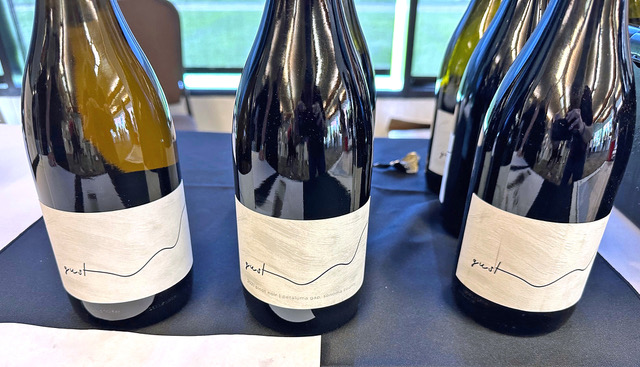
McEvoy Ranch
Long-known for their fine olive oil, McEvoy Ranch first planted part of their northern Marin County property with grapevines in 2006. Since 2012, McEvoy Ranch has also taken over farming 19 acres of vines at nearby Azaya Ranch. Noted vintner Byron Kosuge became the McEvoy winemaker in 2017. The 2021 “Blue Sky” Chardonnay, sourced from La Cruz Vineyard and made with no malolactic fermentation, displayed fresh apple fruit with floral undertones, a vibrant texture and long, clean finish. The 2019 “Evening Standard” Pinot Noir – 65% from the estate vineyard and 35% from Azaya Ranch – was a highlight, with savory black cherry, tea leaf, and spice aromas, fine structure and a lively finish. The 2019 Azaya Vineyard Pinot Noir stepped up the savory and spicy character further along with floral undertones, and had vibrant acidity on the palate. From La Cruz Vineyard, the 2021 “Red Piano” Syrah featured dark berry fruit along with savory herbal notes, pepper, and flowers, with a lively medium-full bodied mouthfeel and plenty of structure for further cellaring.
Panther Ridge Vineyard
Proprietor Suzanne Farver established her Panther Ridge label in 2019. She focuses on Pinot Noir from her 10-acre certified-organic and biodynamically-farmed estate vineyard, which was planted in 2016 on the slopes of Sonoma Mountain at the eastern edge of Petaluma Gap. Adrian Manspeaker makes most of the Panther Ridge wines, while Garry Brooks makes the rosé. The 2022 Rosé of Pinot Noir – farmed and picked for rosé – featured bright and floral red fruit, vibrant acidity, and a long clean finish. The 2020 Pinot Noir had aromas of black cherry, spice, tea leaf, and flowers, with lively acidity and moderate tannins. The pre-release 2021 Pinot Noir, fermented with about 25% whole clusters, showed even brighter red fruit along with an herbal component, with a somewhat lighter texture than the previous wine, and good structure – very youthful at this stage, this will be a candidate for further cellaring when released.
Sangiacomo Family Wines
While the Sangiacomo family has been growing winegrapes in Sonoma County for over 50 years, their wine label was launched in 2016. They farm several vineyards, in Carneros, the Sonoma Coast, and Petaluma Gap regions. James MacPhail is the label’s winemaker, and Director of Sales and Hospitality Meghan Delzell and her husband Dodds poured the Sangiacomo wines at the tasting. The 2020 Roberts Road Vineyard Chardonnay had bright floral aromas plus apple and stone fruit and a touch of spice, medium-bodied with a lively texture and fine acidity on the finish. The 2021 Roberts Road Vineyard Pinot Noir featured both red and black cherry fruit, spice, earth, and hints of flowers, with a pleasant mouthfeel and good structure. The 2021 “Block 11” Pinot Noir is Swan Clone Pinot from Roberts Road Vineyard. This showed more upfront spice on the nose plus red fruit and earth, with a firmer tannic structure – shows potential but really needs time in the cellar to mature.
Thirty-Seven Wines
Proprietors Al and Lisa Brayton founded Thirty-Seven Winery in 2007. Their estate Paradise Vineyard, first planted in 1999, is near the intersection of highways 37 and 121 in one of the coolest spots in the Petaluma Gap. In addition to Chardonnay, Pinot Noir, and Syrah, they grow Albariño, Pinot Gris, Riesling, Grenache, several red Bordeaux varieties, and Blaufränkisch. Shane Finley is the winemaker for Thirty-Seven. The 2021 Grenache had aromas of bright red fruit with savory herbal and spice notes, fine acidity, and a long tasty finish. The 2019 Syrah was a standout – savory and peppery dark berry fruit with hints of smoked meat and dried herbs, medium weight on the palate, with great acidity and a firm tannic finish. The 2018 Reserve Petit Verdot showed a plum and darker berry profile plus herbs with spice in support, rich mouthfeel with loads of structure for further time in the cellar. I finished with a library wine poured from magnum, the 2013 Merlot. Black cherry and plum fruit, spice, dried herbs, and nicely-resolved tannins with a long, pleasant finish.
